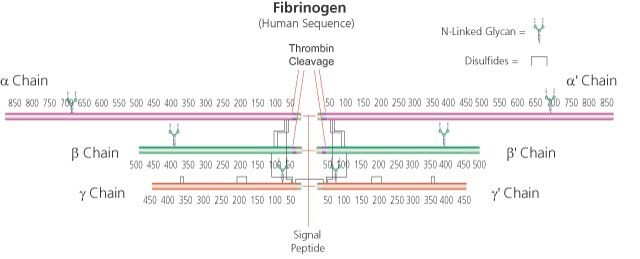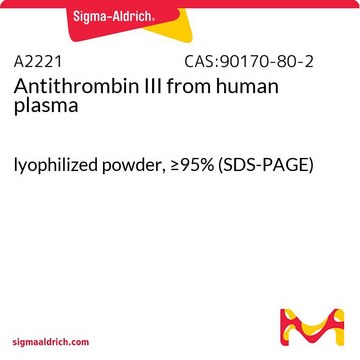T8885
Thrombin from human plasma
lyophilized powder, Suitable for routine use in the thrombin time test
Synonym(s):
Factor IIa
Sign Into View Organizational & Contract Pricing
All Photos(1)
About This Item
Recommended Products
biological source
human plasma
Quality Level
form
lyophilized powder
packaging
vial of ≥10 NIH units
impurities
HIV, hepatitis B and hepatitis C, tested negative
UniProt accession no.
storage temp.
−20°C
Gene Information
human ... F2(2147)
Looking for similar products? Visit Product Comparison Guide
General description
Thrombin is the final coagulation protease in regard to hemostasis, promoting both procoagulant and anticoagulant effects.
Application
Thrombin is used for site specific cleavage of recombinant fusion proteins containing an accessible thrombin recognition site for removal of affinity tags. Thrombin has been used in a study that compared efficacy and safety of low-molecular-weight heparins (LMWHs) to other anticoagulants as venous thromboembolism prophylaxis in major orthopedic surgery.
Biochem/physiol Actions
Serine protease that selectively cleaves Arg-Gly bonds in fibrinogen to form fibrin and fibrinopeptides A and B.
Unit Definition
Activity is expressed in NIH units obtained by direct comparison to a NIH Thrombin Reference Standard
Reconstitution
When reconstituted with 1 ml H2O, one vial will contain 10 mg bovine serum albumin, 0.15 M NaCl and 0.05 M sodium citrate, pH 6.5
Analysis Note
The NIH assay procedure uses 0.2 ml diluted plasma (1:1 with saline) as a substrate and 0.1ml of thrombin sample (stabilized in a 1% buffered albumin solution) based on a modification of the method of Biggs. Only clotting times in the range of 15-25 seconds are used for determining thrombin concentrations.
Other Notes
View more information on thrombin at www.sigma-aldrich.com/enzymeexplorer.
Disclaimer
RESEARCH USE ONLY. This product is regulated in France when intended to be used for scientific purposes, including for import and export activities (Article L 1211-1 paragraph 2 of the Public Health Code). The purchaser (i.e. enduser) is required to obtain an import authorization from the France Ministry of Research referred in the Article L1245-5-1 II. of Public Health Code. By ordering this product, you are confirming that you have obtained the proper import authorization.
inhibitor
Product No.
Description
Pricing
Signal Word
Danger
Hazard Statements
Precautionary Statements
Hazard Classifications
Eye Irrit. 2 - Resp. Sens. 1 - Skin Irrit. 2 - STOT SE 3
Target Organs
Respiratory system
Storage Class Code
11 - Combustible Solids
WGK
WGK 2
Flash Point(F)
Not applicable
Flash Point(C)
Not applicable
Choose from one of the most recent versions:
Already Own This Product?
Find documentation for the products that you have recently purchased in the Document Library.
Customers Also Viewed
Diana M Sobieraj et al.
Pharmacotherapy, 32(9), 799-808 (2012-06-30)
To evaluate the comparative efficacy and safety of low-molecular-weight heparins (LMWHs) versus other anticoagulants as venous thromboembolism prophylaxis in major orthopedic surgery. Systematic review with meta-analysis of 37 randomized controlled trials. Patients undergoing total hip replacement, total knee replacement, or
Michael Hultström et al.
Biomedicines, 10(6) (2022-06-25)
Hypercoagulation and endothelial dysfunction play central roles in severe forms of COVID-19 infections, but the molecular mechanisms involved are unclear. Increased plasma levels of the inflammatory cytokine and TIE2 receptor antagonist Angiopoietin-2 were reported in severely ill COVID-19 patients. In
Deepti Sharma et al.
Communications biology, 5(1), 479-479 (2022-05-20)
Pathological retinal neovascularization (NV) is a clinical manifestation of various proliferative retinopathies, and treatment of NV using anti-VEGF therapies is not selective, as it also impairs normal retinal vascular growth and function. Here, we show that genetic deletion or siRNA-mediated
Michael Ablinger et al.
International journal of molecular sciences, 22(7) (2021-04-04)
Intermediate junctional epidermolysis bullosa caused by mutations in the COL17A1 gene is characterized by the frequent development of blisters and erosions on the skin and mucous membranes. The rarity of the disease and the heterogeneity of the underlying mutations renders
Somasundaram Raghavan et al.
The Journal of biological chemistry, 293(27), 10574-10589 (2018-05-20)
Although signaling of thrombin via its receptor protease-activated receptor 1 (Par1) is known to occur in atherothrombosis, its link to the actual pathogenesis of this condition is less clear. To better understand the role of thrombin-Par1 signaling in atherosclerosis, here
Our team of scientists has experience in all areas of research including Life Science, Material Science, Chemical Synthesis, Chromatography, Analytical and many others.
Contact Technical Service








